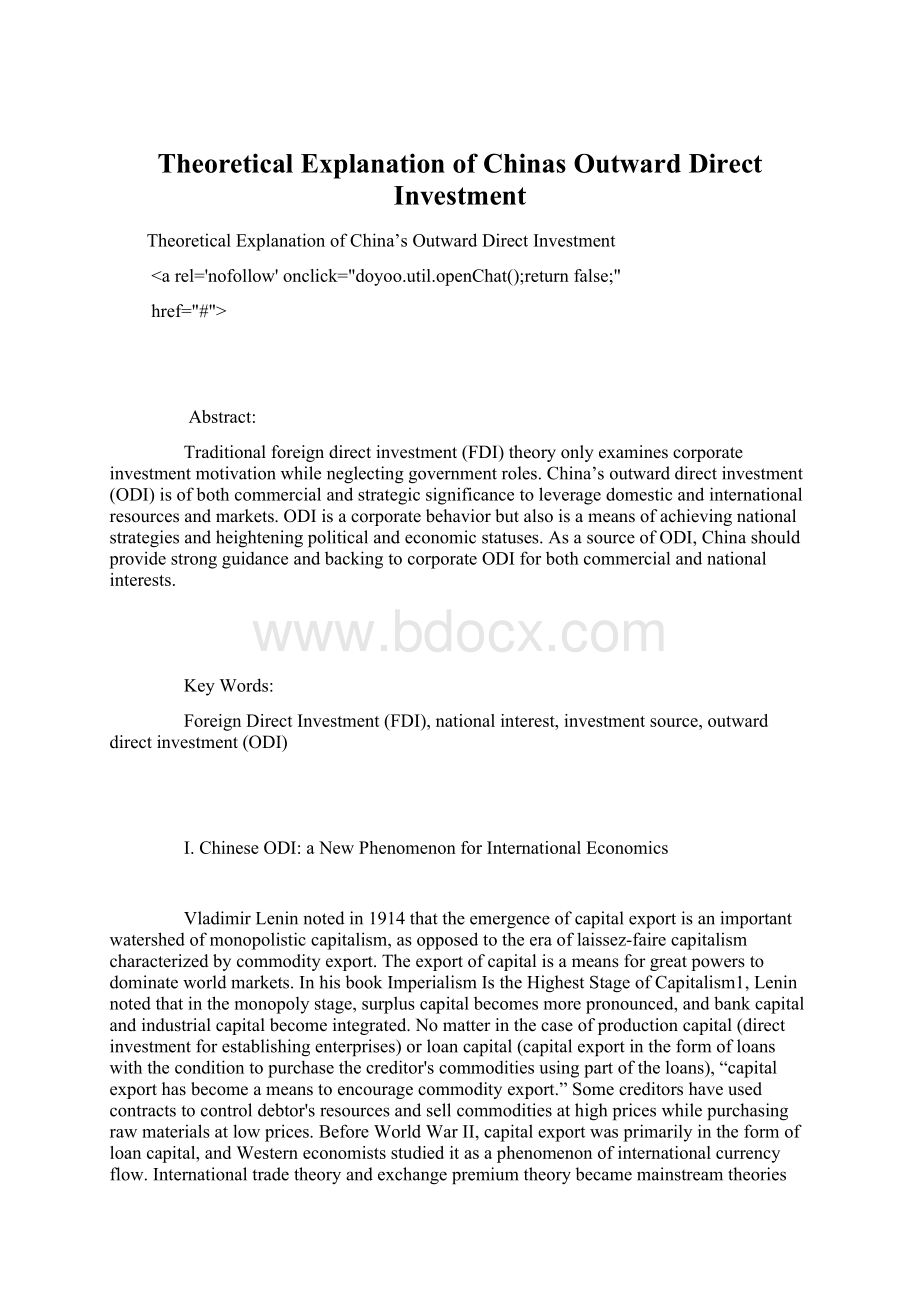Theoretical Explanation of Chinas Outward Direct InvestmentWord文档格式.docx
《Theoretical Explanation of Chinas Outward Direct InvestmentWord文档格式.docx》由会员分享,可在线阅读,更多相关《Theoretical Explanation of Chinas Outward Direct InvestmentWord文档格式.docx(5页珍藏版)》请在冰豆网上搜索。

nofollow'
onclick="
doyoo.util.openChat();
returnfalse;
"
href="
#"
>
Abstract:
Traditionalforeigndirectinvestment(FDI)theoryonlyexaminescorporateinvestmentmotivationwhileneglectinggovernmentroles.China’soutwarddirectinvestment(ODI)isofbothcommercialandstrategicsignificancetoleveragedomesticandinternationalresourcesandmarkets.ODIisacorporatebehaviorbutalsoisameansofachievingnationalstrategiesandheighteningpoliticalandeconomicstatuses.AsasourceofODI,ChinashouldprovidestrongguidanceandbackingtocorporateODIforbothcommercialandnationalinterests.
KeyWords:
ForeignDirectInvestment(FDI),nationalinterest,investmentsource,outwarddirectinvestment(ODI)
I.ChineseODI:
aNewPhenomenonforInternationalEconomics
VladimirLeninnotedin1914thattheemergenceofcapitalexportisanimportantwatershedofmonopolisticcapitalism,asopposedtotheeraoflaissez-fairecapitalismcharacterizedbycommodityexport.Theexportofcapitalisameansforgreatpowerstodominateworldmarkets.InhisbookImperialismIstheHighestStageofCapitalism1,Leninnotedthatinthemonopolystage,surpluscapitalbecomesmorepronounced,andbankcapitalandindustrialcapitalbecomeintegrated.Nomatterinthecaseofproductioncapital(directinvestmentforestablishingenterprises)orloancapital(capitalexportintheformofloanswiththeconditiontopurchasethecreditor'
scommoditiesusingpartoftheloans),“capitalexporthasbecomeameanstoencouragecommodityexport.”Somecreditorshaveusedcontractstocontroldebtor'
sresourcesandsellcommoditiesathighpriceswhilepurchasingrawmaterialsatlowprices.BeforeWorldWarII,capitalexportwasprimarilyintheformofloancapital,andWesterneconomistsstudieditasaphenomenonofinternationalcurrencyflow.Internationaltradetheoryandexchangepremiumtheorybecamemainstreamtheoriesfortheexplanationofinternationalloancapital.ProposedbyGeorgeGoshenin1861,internationalloantheoryholdsthattheimportandexportofgoodsandservices,capitalexportandotherformsofinternationalbalanceofpaymentactivitiesbetweennationswillallgiverisetointernationalloans.Internationalloanswillchangeforeignexchangesupplyanddemand,andthuschangeforeignexchangerates.Inagivenperiodoftime,whenforeignincomeincreaseswhileforeignspendingdecreasesinacountry'
sinternationalbalanceofpayments,foreigncreditswillexceedforeigndebts,whichmeanasurplusininternationalloans.Onthecontrary,ifforeigndebtsexceedforeigncredits,itsinternationalloanswillbeindeficit.Classicinternationalsecuritiesinvestmenttheoryholdsthattheveryexistenceofinternationalsecuritiesinvestmentisthedifferenceofexchangeratesbetweennations.Whenanation'
sinterestrateislowerthananothernation'
s,financialcapitalwillflowfromthelowinterestratecountrytothehigherinterestratecountryuntilthegapisclosed.
AfterWorldWarII,capitalexportbecamedominatedbydirectinvestmentwhichprimarilyoccurredbetweendevelopedcountries.AccordingtotheinterpretationanddefinitionoftheUnitedNationsConferenceonTradeandDevelopment(UNCTAD),fromacommercialperspective,thedifferencebetweendirectinvestmentandloancapital(indirectinvestment)isthatthelatteronlyaimsforcapitalreturns,whiletheformeraimsforbothcapitalreturnsandoperationrightsoroperationalcontrol.Thispromptedeconomiststoshifttheirresearchhorizon.Whymustforeignenterprisesacquireoperationalcontrolwheninvestinginahostcountry?
Withoutcolonialprivileges,whatstrengthsdoforeignenterpriseshavetocompetewithlocalfirmstoachievecapitalreturns?
Thesequestionstriggeredresponsesfromcontemporaryinternationaleconomistsonforeigndirectinvestment(FDI)theoryandmultinationalcompanies,aswellasastringoftheorieslikecorporatespecificadvantagetheory2,internalizationadvantagetheory3andinternationalproductioncompromisetheory4.TheseexplanationsandtheoriesformedthebasicframeworkforcontemporaryFDItheoryandareextensivelyreferencedinthetextbooksofWesterninternationaleconomics.
Withoutadoubt,thesetheoriesweredevelopedtoexplainthecross-borderinvestmentofcompaniesinthemostdevelopedcapitalistindustrializednationsinEuropeandNorthAmerica.Thescopeofanalysisprimarilyappliedtothemutualinvestmentsbetweendevelopednations.Sincethe1960s,however,largecompaniesinsomelate-startingcapitalistcountriesandemergingindustrializedeconomiessuchasJapan,SouthKoreaandSingaporestartedtoinvestabroad,includingtolessdevelopedeconomies.Thischangedthecompositionofmultinationalcompanies.ComparedtolargecompaniesinEuropeandNorthAmerica,theircross-borderinvestmentsarenotmarkedwithclearcorporatespecificadvantagesorinternalizationadvantages.Thequestionishowtoexplaintheirinvestmentbehaviorsgivensuchweaknesses?
Using“marginalindustrialrelocationtheory,”5JapanesescholarKiyoshiKojimaexplainedthe“flyinggeesepattern”formedintheprocessofindustrialrelocationinEastAsia,whichisactuallyadynamicextensionofcomparativeadvantagesandsharessimilarcharacteristicswithJohnH.Dunning'
slocationtheory.TheseEasternandWesterntheoriesdominatedinternationaleconomicstextbooksforfortytofiftyyears.
Afterthe1980s,economicliberalizationsweptacrosstheworld.Economicglobalizationadvancedwithgreaterspeed,internationaldirectinvestmentsbecamemorecomplex,andtheoriginofmultinationalfirmsbecamemorevaried.Inparalleltocontinuedmutualinvestmentsbetweendevelopedcountries,thereemergedlargeinvestmentflowsfromtheNorthtotheSouth,betweentheSouthandtheSouth,andeveninverselyfromtheSouthtotheNorth.Inthefaceofthesenewdevelopments,mainstreamtheoriesininternationaleconomicstextbooksbecamepuzzled.Corporateinvestmentfromdevelopingeconomiestoricheconomies,inparticular,madeexistingtheoriesimpotent.Amongtheoriesondirectinvestmentofdevelopingcountries,thesmall-scaletechnologytheoryofWells(1983)isregardedasapioneeringresearchoutcomeonmultinationalcompaniesfromthedevelopingworld.Accordingtosmall-scaletechnologytheory,thecomparativeadvantageofcompaniesindevelopingcountriescomesfromlowcosts,whichreflectsthemarketcharacteristicsofhomecountries.Suchlow-costadvantagescomefromthefollowingsources:
possessionofsmall-scaleproductiontechnologiesforasmallmarket;
nationalproductsthatarepopularabroad;
alow-pricemarketingstrategy,etc.Giventhediverseandmulti-tieredworldmarket,evenforlessadvancedsmallfirms,theirlow-costadvantagestillpresentspowerfulcompetitiveness.Their“localcontentandspecialproducts”and“low-pricemarketingstrategy”makeitpossibleforthemtocompetewithmultinationalsfromdevelopedcountries.Accordingtosmall-scaletechnologytheory,evenenterprisesfromdevelopingcountrieswithsimpletechnology,alimitedbusinessscopeandasmallcapacitycanstilljoininternationalcompetitionthroughoutwarddirectinvestment(ODI).
WithresearchonthecompetitivestrengthandinvestmentmotivesofIndianmultinationalcompanies,Lall(1983)developedhistechnologylocalizationtheoryonODIfromdevelopingcountries.Thistheoryholdsthatcorporatetechnologyformationindevelopingcountriescontainsinnovationactivitiesthatleadtospecificadvantages.Developingcountriesprovideadifferentenvironmentforcreatingtechnologyandknowledge.Theirtechnologiesareusuallylaborintensive,andtheirproductsareuniquetolocaldemandandthedemandofcountriesofequivalentincomelevels.Thatiswhydevelopingcountriesalsohavespecificadvantages.Technologylocalizationtheorystressesthatwhatdevelopingcountriesdoisnotsimplyduplicatetechnologiesfromdevelopedcountries;
whattheydoistolearn,improveandinnovate.Itissuchinnovationthatbringsnewvitalityintointroducedtechnologies.Italsobringsnewcompetitiveadvantagestotheenterprisesandenablesthemtobecompetitiveinthelocalmarketandthemarketsofneighboringcountries.TheabovetwotheoriesexplainedODIfromdevelopingcountriesusingmicro-leveltheories,andexplainedwhatmakesitpossiblefordevelopingcountriestohavecomparativeadvantageswhiletakingpartininternationalproductionandbusinessactivities.
Inthelate1980s,ProfessorMichaelE.PorterofHarvardBusinessSchoolproposedtheideaofan“internationalproductionvaluechain”inhiscross-borderbusinesstheory.This,tosomeextent,madeupforthedefectsofexistinginternationaldirectinvestmenttheories.Usingtheconceptof“valuechain,”Porter(1986)describedtheprocessthroughwhichmultinationalsdeveloptheirstrategiesandcompetitiveness.Specifically,twostrategicvariablesarecrucial:
thefirstistheintegrationofcorporatebusinessactivitiesworldwide,i.e.whenorganizingbusinessactivitiesofvariouspartsofthevaluechain,multinationalcompaniesmustunderstandtheirworldwidelocations.Second,internalcoordination,i.e.whenconductingtheabove-mentionedbusinessactivities,multinationalcompaniesmustunderstandhowvariouslinksofthevaluechainarecoordinated.Porterholdsthatcompetitivenesscomesfromtwoaspects:
firstisthevalueactivitiesthemselves,whicharefundamental.Theotherisvaluechainlinkage,whichmeanstherelationshipbetweenhowaval